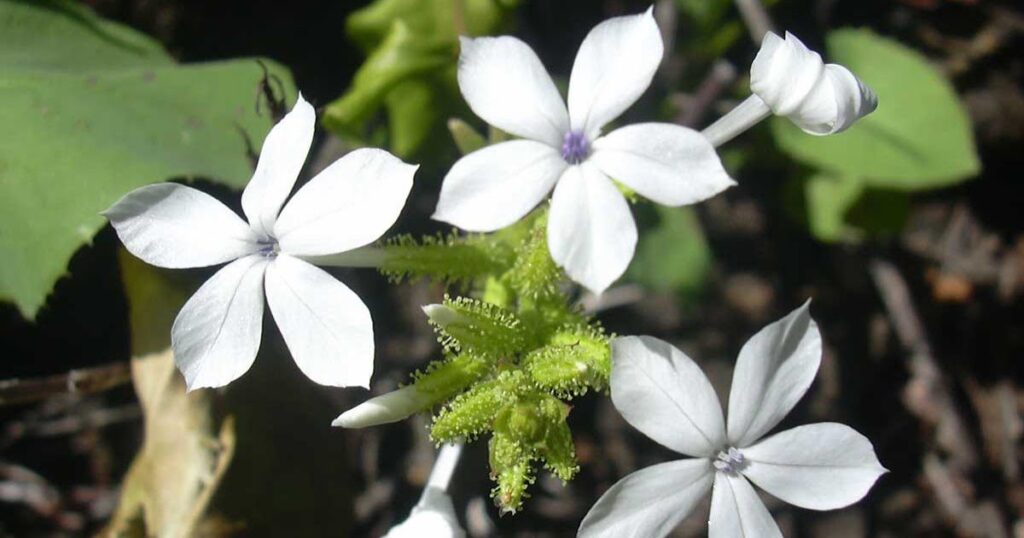Herb
Citraka (Plumbago zeylanica) Herb Ayurvedic Overview
Citraka (Plumbago zeylanica) is a large perennial sub-scandent shrub, found throughout India in a wile state and occasionally cultivated in gardens. It is about 1.5-2.0 m tall, with ram-bling branches. Its active growth occurs during the rainy season and ceases in the post-flowering stage. Throughout India, it is cultivated in the wild in the W. peninsula and probably in Bengal, Malay peninsula. The ethanolic extract of P.zeylanica has antimicrobial properties and shows activity against Salmonella typhi, Pseudomonas aeruginosa, Bacillus subtilis, and Staphylococcus aureus.
Plumbago zeylanica is a medicinal herb used in the Indian Traditional System of Medicine for a long year in managing various health conditions. It amazingly works in digestive weakness, constipation, piles, rheumatism, muscular pains, etc. Citraka (Plumbago zeylanica) is rich in anti-inflammatory, anti-bacterial, anti-tumor, hepatoprotective, anti-fungal, anti-hyperglycemic, anti-atherosclerotic, antimicrobial, anti-plasmodial properties.
Table of Contents
Scientific Classification of Citraka (Plumbago zeylanica):
- Kingdom: Plantae
- Division: Phanerogames
- Sub division: Angiosperms
- Class: Dicotyledonae
- Sub class: Gamopetalae
- Series: Heteromerae
- Order: Primulales
- Family: Plumbaginaceae
- Genus: Plumbago L.
- Species: zeylanica
Citraka (Plumbago zeylanica) Synonyms:
- Sanskrit: Agni, Vahni, Jvalanakhya, Dahana, Hutabhuk, Krsanu
- Assamese: Agiyachit, Agnachit
- Bengali: Chita
- English: Lead war
- Gujrati: Chitrakmula
- Hindi: Chira, Chitra
- Kannada: Chitramula, Vahni, Bilichitramoola
- Kashmiri: Chitra, Shatranja
- Malayalam: Vellakeduveli, Thumpokkoduveli
- Marathi: Chitraka
- Oriya: Chitamula, Chitoparu
- Punjabi: Chitra
- Tamil: Chitramoolam, Kodiveli
- Telugu: Chitramulam
- Urdu: Sheetraj Hindi, Cheetah
Citraka (Plumbago zeylanica) Description:
a) Macroscopic: The roots of Citraka are 30 cm or more in length, 6 mm or more in diameter, and short, thick pieces. The rootstocks are reddish to deep brown, scars of rootlets present, bark thin and brown, internal structure striated, odor, disagreeable, taste, acrid.
b) Microscopic: The transverse section of the Citraka root shows outermost tissue of cork consisting of 5 -7 rows of cubical to rectangular dark brown cells. The secondary cortex consists of 2-3 rows of thin-walled rectangular, light brown cells, out of which most of the cortex cells contain starch grains. It is mainly composed of large polygonal to tangentially elongated parenchymatous cells that differ in shape and size—it containing starch grains and some cells with yellow contents. The fibers are scattered singly or in groups of 2-6, thin-walled cells, consisting of usual elements and phloem fibers.
Like cortical zone, phloem fibers are usually in groups of 2-5 or more, lignified with pointed ends and narrow lumen, similar in shape and size to those of the secondary cortex. The cambium is indistinct, and xylem is light yellow to whitish, vessels radially arranged with pitted thickenings, medullar rays straight, 1-6 seriate, cells radially elongated starch filled with starch grains, stone cells absent.
Identity, Purity, and Strength of Citraka (Plumbago zeylanica):
- Foreign matter Not more than 3 percent, Appendix 2.2.2.
- Total Ash Not more than 3 percent, Appendix 2.2.3.
- Acid-insoluble ash Not more than 1 percent, Appendix 2.2.4.
- Alcohol-soluble extractive Not less than 12 percent, Appendix 2.2.6.
- Water-soluble extractive Not less than 12 percent, Appendix 2.2.7.
Chemical Constituents of Citraka (Plumbago zeylanica):
The main constituents of Citraka are Plumbagin, Chitranone, Zeylanone, Plumbagicacid, B-Sitosterol, 3, 3-biplumbagin, 3-chloroplumbagin, elliptinone, droserone, isoshinanolone, maritinone, 4-naphthoquinone, suberosin, Xanthyletin, and xanthoxyletin. Other than this, the essential compounds are present in the plant are Plumbagin acid, β sitosterol, 2, 2-dimethyl-5-hgydroxy-6- acetylchromene, saponaretin, isoaffinetin, etc. Among all these Plumbagin, is the essential bioactive compound present in P. zeylanica.
Ayurvedic Properties and Action of Citraka (Plumbago zeylanica):
- Rasa: Katu
- Guna: Laghu, Ruksha, Tikshana
- Virya: Ushna
- Vipaka: Katu
- Karma: Deepan, Shoth hara, Grahi, Pachan, Kapha vata hara, Arsho hara, Shoola hara.
Ayurvedic Formulation made by Citraka (Plumbago zeylanica):
Plumbago zeylanica formulations are Citrakadi vati, Citrakadi Chooran, Chitrakadi Leha, Chitrak Rasayana, Chitrakadi Avleha.
Therapeutic Uses of Citraka (Plumbago zeylanica):
The main indications of Citraka (Plumbago zeylanica) are Agnimandaya, Grahani Roga, Guda shoth, Udar Shoola, Arsha.
Dose of Citraka (Plumbago zeylanica):
1-3 gm of the drug in powder.
Reference:
Ayurvedic Pharmacopeia of India.



